

Silico Screening of Zinc II Enzyme Inhibitors Using ILP Tadasuke Ito Shotaro Togami Shin Aoki and Hayato Ohwada Department of Industrial Administration Tokyo University of Science ID: 257860
Download Presentation The PPT/PDF document "1 In" is the property of its rightful owner. Permission is granted to download and print the materials on this web site for personal, non-commercial use only, and to display it on your personal computer provided you do not modify the materials and that you retain all copyright notices contained in the materials. By downloading content from our website, you accept the terms of this agreement.
Slide1
1
In
Silico Screening of Zinc (II) Enzyme Inhibitors Using ILP
Tadasuke
Ito,
Shotaro
Togami
,
Shin
Aoki
and
Hayato
Ohwada
Department
of Industrial
Administration
Tokyo University of Science Slide2
2
In-
silico screening is a powerful, low-cost
method of
finding strong
binders for proteins and enzymes
・Structure-Based Virtual Screening (SBVS)
Introduction 1/4
・
Ligand-Based Virtual Screening (LBVS)
⇒ Docking Simulation
⇒ Machine Learning
(
FingerPrint
, Chemical
Descriptor, …)Slide3
3
Introduction 2/4
・
Machine Learning
・
Inhibitor
DataBase
ligand
decoy
・
Machine
Learning Method
Inhibitor
candidates
SVM
,
RandomForest
, …
ILP
classification
model
ResultSlide4
4
CAH2 contain zinc.
CA inhibitors
Introduction 3/4
Remedy
・
Epilepsy
Catalytic reaction :
Carbonic
anhydrase II (CAH2)
CAH2
・GlaucomaSlide5
5
Drug-discovery researchers
expectsIntroduction 4/4
Our objective is
s
creening
many inhibitor candidates of CAH2
high classification
performance
for inhibitorsclear
classification modelClassifier provides
high classification performance
graphical
classification
modelSlide6
6
Data
Extraction Method 1/4
Obtain ligands and decoys
actives_final.mo2
⇒
Ligand(inhibitor)decoys_final.mol2
⇒Decoy(non-inhibitor)
Database
of Useful
Decoys: Enhanced
(DUD-E)
Number of CA inhibitors
Database
Training dataSlide7
7
Machine
learning with ILPMethod 2/4
Clauses(Input)
・
bond(compound,
atomid, atomid,
bondtype)・
atom(compound,
atomid, atomtype)
・ring(compound, ringid,
atomid, ringsize)
ILP
system :
GKS
Input data :
CompoundStructure
actives_final.mo2
decoys_final.mo2
Extraction
Rule(Output)
bond(A
, B, C, 2), atom(A, B, cl), ring(A, D, B, 6)
Class
Positive
⇒
Ligand(actives_final.mo2)
Negative
⇒
D
ecoy(decoys_final.mo2)Slide8
8
Method 3/4
training data
If
the
compound
applies to rules,the predicted value is 1.If not,
the predicted value is 0.※1 : ligand, 0 : decoy
test data
bond(A, B, C, 2), atom(A, B, cl), ring(A, D, B, 6)
applies to rules
Compound 1
Compound 2
Compound 3
….
Compound n
m
ake rules
l
igand or decoy?Slide9
9
Evaluation method
Method 4/4
Ligand : 14
Decoy : 8
22 inhibitor candidates that are not included in DUD-ESlide10
10
Classification result
Results 1/4
Data set
training data :
ligands = 492, decoys = 3000
test data : ligands = 14, decoys = 8
Parametersdepth = 10, negative = 10, positive = 10, clause_size = 6
Output11 rulesSlide11
11
Results 2
/4dock(A) :- atom(A, B, s),
bond(A
, C, B, 1), bond(A, B, D, 2),
dock(A) :- bond(A, C, E, 1), bond(A, E, F, 2),
ring(A, G, F, 6)Rule 2
Score
Training dataPositive : 125 / 492 Negative : 8 / 3000
Test data Positive : 12 / 14
Negative : 2 / 8Slide12
12
Results 3
/4dock(A) :- bond(A, B, C, 1),
atom(A
, C, s),
bond(A, D, B, 2),
dock(A) :- bond(A, E, D, 1), bond(A, C, F, 2), ring(A
, G, E, 5)
Rule 1
ScoreTraining dataPositive : 118 / 492 Negative : 7 / 3000
Test data Positive : 1 / 14
Negative : 0 / 8Slide13
13
Results
4/4dock(A) :- bond(A, B, C, 1),
atom(A
, B, s),
atom(A, C, n), dock(A) :-
bond(A, D, B, 1), bond(A, D, E, 2), ring(A, F, D, 6)
Rule 4Score
Training data
Positive : 191 / 492 Negative : 10 / 3000Test data Positive
: 1 / 14Negative : 0
/ 8
sulfonamideSlide14
14
Conclusion
Machine Learning : Inductive Logic
Programming (ILP
)
Database : Database of Useful Decoys: Enhanced (DUD-E
)Target enzymes : Carbonic anhydrase II predict
s ligand high
performance
Methodprovides a clear classification model
Classified new
inhibitor candidates (14 ligands, 8 decoys)Our method could be applied to
other zinc enzymes
.
angiotensin-converting
enzyme
,
histone deacetylase
,
metallo
-B-
lactamase
, …